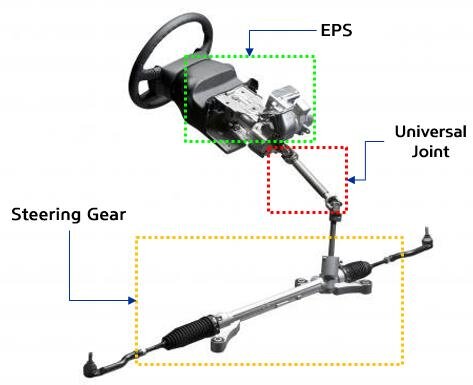EPS é um sistema de direção hidráulica eletrônica que utiliza a potência gerada pelo motor elétrico para auxiliar o motorista na direção hidráulica. Como parte importante do veículo, o sistema de direção é um dos principais componentes que afetam a estabilidade, o conforto e a segurança do veículo.
No projeto do sistema de direção, para amenizar a contradição entre a leveza e a sensibilidade da direção automotiva, a maioria dos veículos comerciais e 50% dos automóveis utilizam sistemas de direção hidráulica. Desde a década de 1950, o sistema de direção hidráulica passou por três estágios de desenvolvimento: direção hidráulica convencional (HPS), direção eletro-hidráulica (EHPS) e direção elétrica (EPS), com uma tendência contínua de desenvolvimento em direção a sistemas eletrônicos e inteligentes.
A composição do sistema EPS
O sistema de direção hidráulica eletrônica EPS é baseado no sistema de direção mecânica tradicional. De acordo com o sinal de torque no volante e o sinal de velocidade do veículo, o dispositivo de controle eletrônico faz com que o motor gere potência auxiliar de tamanho e direção correspondentes para auxiliar o motorista nas operações de direção. Ele pode facilmente fornecer diferentes efeitos de assistência elétrica ao motor em diferentes velocidades do veículo, garantindo que o carro seja leve e flexível ao fazer curvas em baixas velocidades, tenha sensibilidade suficiente à estrada ao fazer curvas em altas velocidades e seja estável e confiável. Embora diferentes veículos tenham componentes estruturais diferentes, a estrutura do sistema EPS é geralmente a mesma. Geralmente é composto por um sensor de torque (direção), uma unidade de controle eletrônico, um motor, um redutor, uma caixa de direção mecânica e uma fonte de alimentação de bateria.

Os motores utilizados em EPS são divididos em motores com escovas e motores sem escovas
Motores com escovas alternam a corrente enquanto as escovas e o comutador giram, e podem girar quando a energia é ligada. São de baixo custo, mas os enrolamentos dos motores com escovas são dispostos no lado do rotor. À medida que a potência de saída aumenta, o momento de inércia do motor aumenta, e o problema da baixa sensibilidade da direção precisa ser resolvido.
O motor sem escovas em si não possui função retificadora, sendo necessário um sensor de ângulo integrado. A estrutura de corrente do sinal de ângulo correspondente é complexa e custosa para comutar através do circuito. No entanto, os enrolamentos do motor sem escovas são dispostos no lado do estator e o rotor é um ímã permanente. Mesmo que a potência de saída aumente, o problema do momento de inércia pode ser suprimido.
Materiais de ímã permanente em motores EPS
O EPS possui requisitos muito elevados para o desempenho, peso e volume de motores de ímã permanente, portanto, os materiais de ímã permanente utilizados são principalmente ímãs de NdFeB de alto desempenho, que atualmente são principalmente NdFeB sinterizado. Os graus comuns são 45H, 48H, 38SH, 40SH, 42SH, 48SH, 35UH, etc. No futuro, espera-se que o NdFeB prensado a quente substitua o NdFeB sinterizado no EPS, mas a tecnologia ainda não está madura e o custo ainda é alto, portanto, o NdFeB sinterizado ainda é o principal.
Direitos autorais
@2024 Nanjing Huajin Magnet Co., Ltd. Todos os direitos reservados
.
Mapa do site
/ blog
/ Xml
/ política de Privacidade
 SUPORTADO POR REDE
SUPORTADO POR REDE
